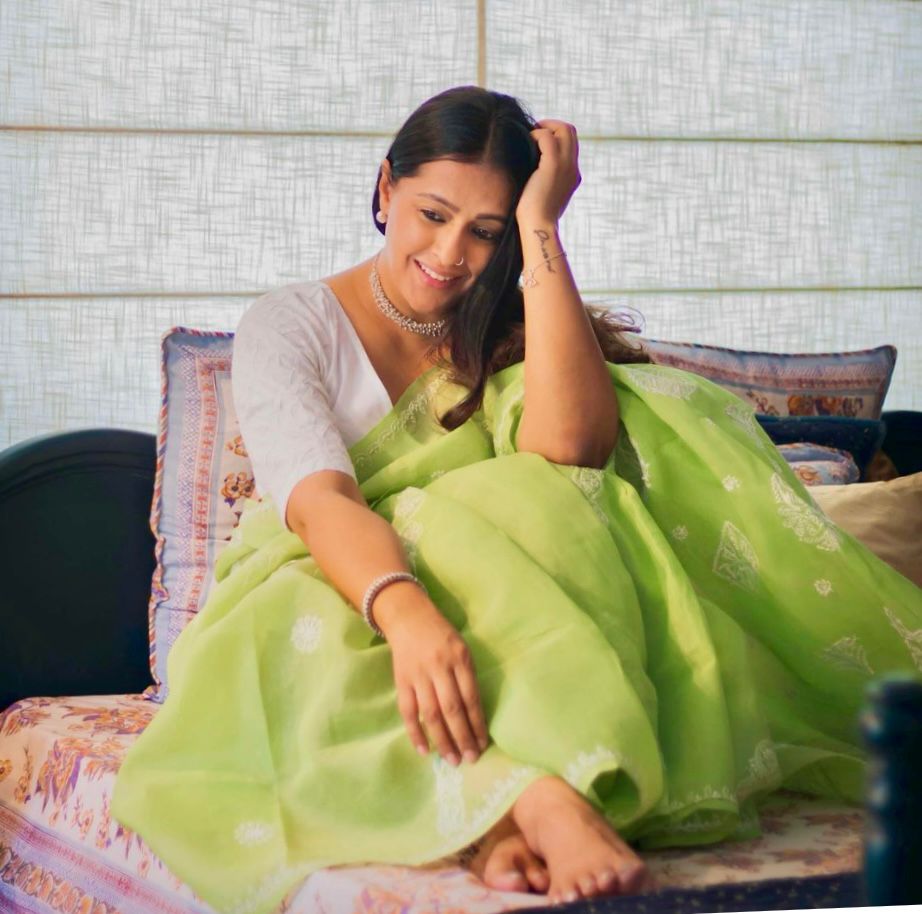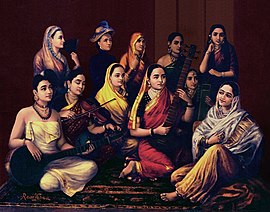If you've ever watched a period drama or any movie from the bygone era, the elaborate costumes are sure to catch your attention. Be it Bridgerton, Devdas or Bajirao Mastani. The way the protagonist is dressed in powerful attire definitely leaves a mark on us.
As evidenced by paintings like A Galaxy of Musicians and other historical works, we Indians have always appreciated the diversity in dress and adornment. We can see this reflected in Varma's painting of 11 women from various regions of India.

Source: Wikipedia
For many years, people have been fascinated by the different ways sarees can be draped. In India, there are different ways in which sarees can be draped.
Here we talk about some of the styles from various parts of India.
Nauvaari -
Source: Google
If you grew up in Maharashtra, you've probably seen women of all ages and walks of life wearing a Nauvari saree! The traditional Maharashtrian Nauvari saree measures 8-9 metres in length. It resembles a man's dhoti or wrapped trousers worn without a petticoat. Women wear a pallu to cover the upper half of their bodies.
According to legend, during the Maratha reign, women were entrusted with the responsibility of assisting their fellow male warriors. This is when they introduced the saree, which looks like male trousers when worn traditionally. The goal was to make movement easier. Since then, the Nauvari saree has become the traditional Maharashtrian women's attire.
Nivi drape-

Source: ForSarees
Jnanadanandini Devi, Rabindranath Tagore's sister-in-law pioneered the new style of combining the saree with a blouse and petticoat. It came to be known as the Nivi drape. She accomplished this by fusing Parsi and Bengali styles. She kept the Bengali style of wearing the pallu on her left shoulder while wearing the Parsi jacket and petticoat. This style, which lacked pleats from the waist down, was popular among ladies.
Jnanadanandini Devi, a social reformer and advocate for women's empowerment even taught women interested in learning the new saree draping technique.
Parsi Drape-

Source: Google
During their trade journeys to China, Parsi men discovered a beautiful silk fabric called 'gaaj' or 'paaj,' which was so beautiful that they bought yards for their wives. This fabric was later embellished with lovely and intricate embroidery. While the length of the embroidery varied, a minimum of 3.5 inches along the border was required. The embroidery designs and patterns were influenced by both Iranian and Hindu cultures.
A Parsi bride's trousseau includes the Gara, an age-old Parsi tradition. It is passed down from mother to daughter and preserved for future generations. Despite changes in the political and social climate, the Gara has remained consistent while evolving beautifully.
Athpourey

Source: Google
Until recently, an intermediary form of draping a saree, which was shorter in length and worn without a blouse or petticoat, was popular in Bengal. It was known as athpourey draping, and many of us have seen our grandmothers wear sarees in this manner. While athpourey is still popular during festivals and is used in Bollywood films to portray a Bengali woman, it is now paired with a blouse and petticoat.
The Pallu is draped from back to front on both sides. Traditionally, a slew of keys is attached to the Pallu's end. Thakurains in Bengal used to wear their sarees like this in the past.
Makhela Chadar

Source: Google
A Mekhela is typically made up of two pieces of cloth, one draped around the upper half of the body and one draped around the lower half. The bottom half consists of a round-fitted skirt (petticoat) that extends from the waist to the ankles and is often pleated, similar to a traditional Indian saree. The bottom is paired with a Chador (meaning "cover"), which is a piece of cloth wrapped around a matching blouse and then let loose at one end, similar to a saree. The other end is tucked into the skirt's upper portion.
Women not only wear mekhela, but they also weave it.
Coorgi

Source: Google
This style of saree-draping was introduced to make it easier for women to climb the hilly slopes of the Western Ghats. It enabled them to actively climb trees and perform their daily tasks.
A Coorgi-style saree has pleats at the back, and the saree's end or veil is brought from the back under both shoulders and then knotted on the right shoulder.
We truly admire the different ways in which our women carry the saree. This versatile garment has been with us through the years.
Studying the trends of different regions when it comes to saree draping is a fun way to learn about Indian culture and the diversity within our country. And if you are part of any of the regions listed here, don't hesitate to share with us your preferred style.



